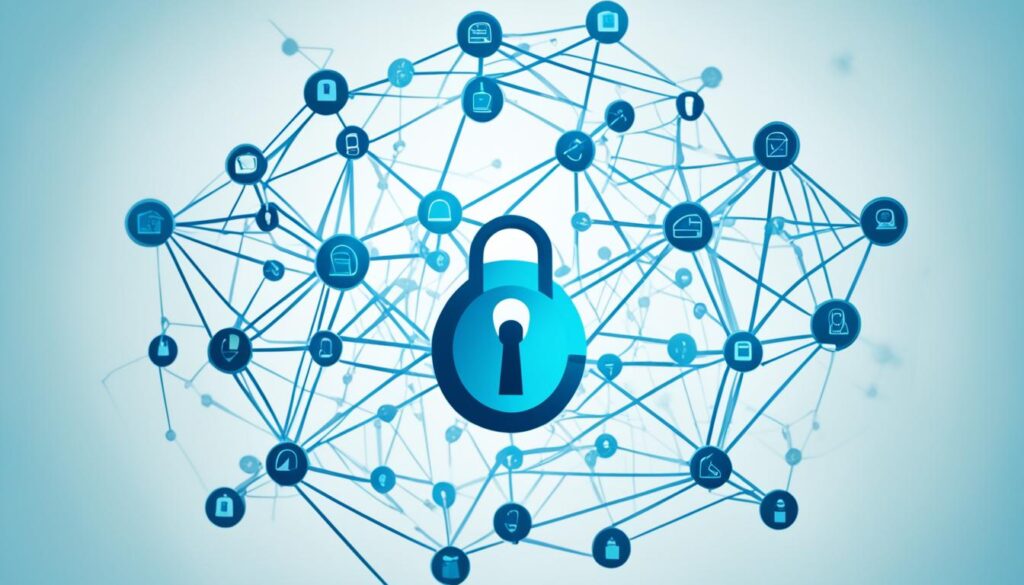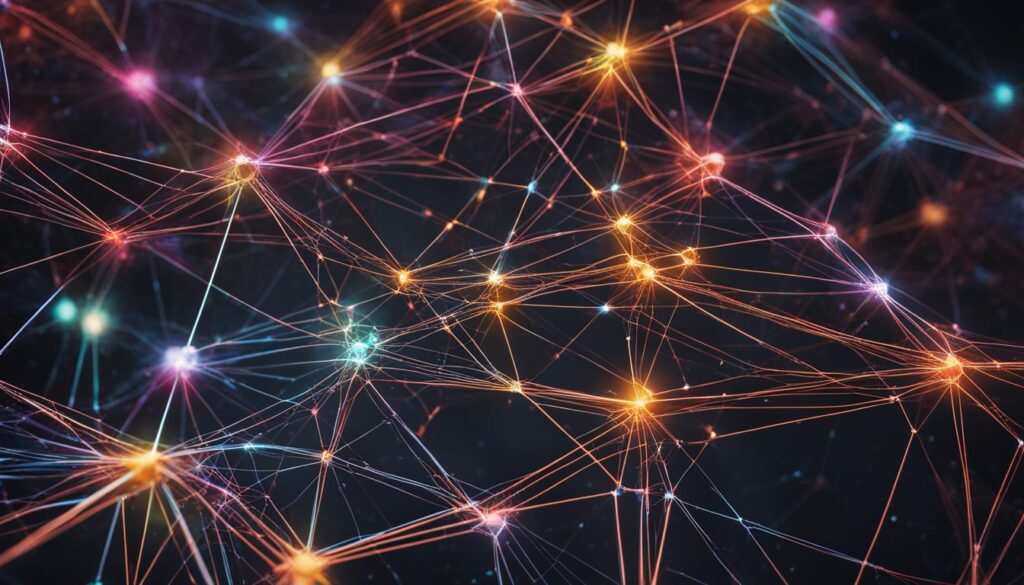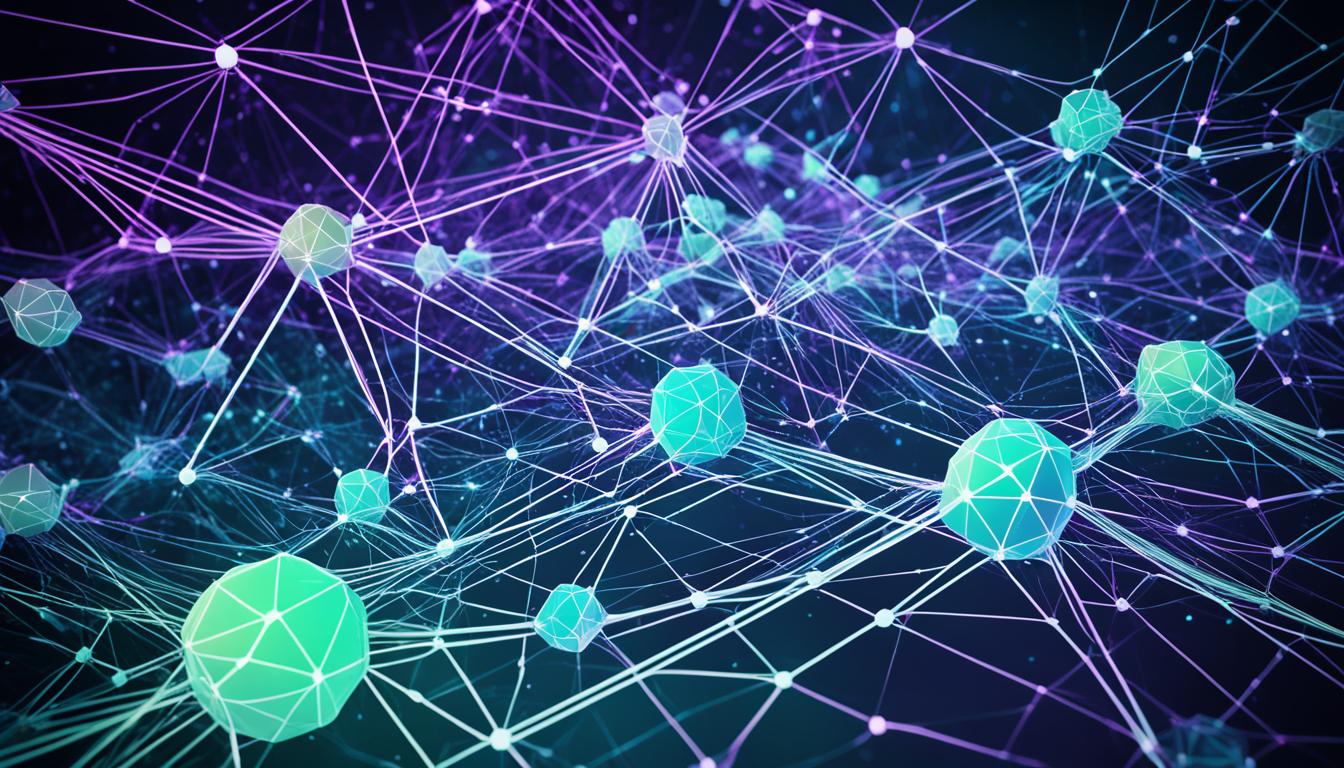Welcome to the era of Web 3.0, where data ownership and privacy take center stage. In a world dominated by digital interactions, concerns about data security and control have become paramount. The current centralized model of Web 2.0 raises questions about who can access and manipulate our data. However, with Web 3.0, a decentralized version of the internet, users regain ownership and control over their data.
In Web 3.0, data decentralization is the key. By leveraging technologies such as blockchain, artificial intelligence, and the Internet of Things (IoT), Web 3.0 aims to create a more user-friendly and privacy-centric digital experience. This new paradigm empowers individuals, giving them the power to decide how their data is used and shared.
Key Takeaways:
- Data decentralization is a fundamental aspect of Web 3.0, ensuring users have ownership and control over their data.
- Web 3.0 utilizes technologies like blockchain, AI, and IoT to enhance data privacy and security.
- With Web 3.0, users have the ability to determine who can access their data and can revoke access privileges if needed.
- Web 3.0 has the potential to rebalance power structures, address wealth inequality, and enable more meaningful interactions between marketers and consumers.
- The concept of decentralization in Web 3.0 brings benefits such as increased security, protection against censorship, and prevention of data misuse.
The Need for Web3 Data Privacy
In the current web2 framework, concerns about data privacy and misuse have arisen due to tech giants having unlimited power over user data. With the centralized control of data in web2, users have become increasingly worried about the privacy and security of their personal information.
Data privacy regulations like the California Consumer Privacy Act (CCPA) and the General Data Protection Regulation (GDPR) were introduced to address these concerns. However, these regulations have limitations and do not provide comprehensive protection against data breaches and unauthorized access.
Web3 technology aims to redefine the web by addressing these problems with data privacy. By utilizing decentralized technologies like blockchain, AI, and IoT, web3 offers a more secure and privacy-focused internet experience. Web3 empowers users by giving them ownership and control over their data, eliminating the need to rely on third-party intermediaries.
Understanding the principles and definitions of web3 is crucial in discussing its impact on data privacy. Web3 represents a paradigm shift in web technology, emphasizing the importance of decentralization and user-centric approaches. It encompasses various innovative solutions that prioritize data privacy and security.
“Web3 aims to redefine the internet by putting control back in the hands of users, ensuring data privacy and security in an increasingly digital world.”
Problems with Data Privacy in Web2
In the web2 framework, data privacy concerns arise due to the following factors:
- Data Centralization: Tech giants collect and store vast amounts of user data, creating a central repository vulnerable to breaches and misuse.
- Lack of User Control: Users have limited control over their personal data, as it is stored and managed by third-party platforms.
- Data Monetization: Companies profit from user data through targeted advertising and data monetization practices without explicit user consent.
- Security Risks: Centralized databases are attractive targets for cyberattacks, posing a significant risk to user privacy.
Definitions of Web3
Web3 refers to the next generation of internet technology that aims to decentralize power, enable user ownership, and prioritize data privacy. It is characterized by the following:
- Decentralization: Web3 utilizes technologies like blockchain to remove central authorities and distribute data across a network of nodes.
- User Empowerment: Web3 strives to give users control and ownership of their data, enabling them to make informed decisions about its usage.
- Enhanced Privacy: Web3 technologies prioritize user privacy by implementing cryptographic protocols and ensuring data encryption.

| Web2 Data Privacy Concerns | Web3 Data Privacy Solutions |
|---|---|
| Central control of user data | Decentralized data storage and management |
| Limited user control over data | Empowerment and ownership of data |
| Data monetization without consent | User-controlled data sharing and monetization options |
| Security vulnerabilities | Enhanced data encryption and decentralized security measures |
How Web3 Ensures User Privacy
Web3, the decentralized version of the internet, offers significant advancements in user privacy and data ownership. By leveraging blockchain technology, Web3 empowers individuals by giving them control over their data, enhancing privacy and security.
One of the key features of Web3 is data ownership. Unlike the current web2 framework where data is controlled by centralized entities, Web3 enables users to have full ownership and control over their data. This shift in ownership provides individuals with the freedom to decide how their data is shared and used.
Blockchain technology plays a crucial role in optimizing user experience and ensuring transparent access to data in Web3. With the use of distributed ledgers and smart contracts, users can have complete visibility into how their data is being utilized. This transparency fosters trust between users and service providers, ensuring that data is handled responsibly and ethically.
Incentives are introduced in Web3 ecosystems to encourage fair and transparent behavior. Users are incentivized to share their data with trusted entities in exchange for various rewards such as tokens or access to exclusive services. This incentive-driven approach promotes a balance between data sharing and privacy, giving users the agency to make informed decisions about their data.
Moreover, Web3 emphasizes improved cybersecurity measures to protect user data from breaches and unauthorized access. With the use of decentralized networks and cryptographic protocols, Web3 enhances the security of data storage and transmission. This heightened security reduces the risk of data breaches and ensures that user information remains confidential.
Web3 not only revolutionizes data ownership but also enhances user privacy through its decentralized architecture and transparent incentives. By empowering users with data control, promoting transparency, and improving cybersecurity, Web3 sets a new standard for privacy in the digital age.

The Transformative Power of Web3
Web3 has the potential to revolutionize the digital landscape by rebalancing power structures and empowering individuals. Unlike the current web2 framework, which centralizes control and data ownership, web3 aims to create a more equitable and user-centric internet experience.
In web3, the transformative power lies in its ability to challenge the capture of value for personal gain and focus on the creation of genuine value for others. This shift towards value creation fosters a more inclusive and collaborative digital ecosystem, where individuals and communities can thrive.
One of the key areas where web3 can make a significant impact is in addressing wealth inequality. By promoting decentralized ownership and control of assets, web3 provides opportunities for wealth creation and distribution that are more accessible and transparent. This has the potential to create a more equitable society where everyone has a stake in the digital economy.
Another aspect of web3 that is transforming the digital landscape is opt-in marketing. Unlike traditional web2 marketing methods that rely on intrusive and targeted advertising, web3 allows for a more personalized and voluntary approach. Users have the freedom to choose the marketing content they want to engage with, leading to more meaningful interactions and a better overall user experience.
“Web3 represents a paradigm shift in the digital world, transforming the way we create, interact, and transact online. It challenges existing power structures, addresses wealth inequality, and puts the control back in the hands of users.”
Comparing Web2 and Web3
| Web2 | Web3 |
|---|---|
| Centralized control and ownership of data | Decentralized data ownership |
| Value capture for personal gain | Focus on creating value for others |
| Increasing wealth inequality | Addressing wealth inequality |
| Intrusive and targeted advertising | Opt-in marketing and voluntary engagement |
Web3 holds the promise of a more equitable and inclusive digital future. By rebalancing power structures, creating value for others, addressing wealth inequality, and embracing opt-in marketing, web3 is transforming the way we interact with the internet and each other.

The Concept of Decentralization in Web3
Web3 is built on the fundamental principle of decentralization, which revolutionizes how data is stored and accessed. Unlike the centralized model of Web2, where data is controlled by a single entity, Web3 employs a distributed approach, ensuring increased security, privacy, and user empowerment.
In Web3, data is stored on a peer-to-peer network, eliminating the dependence on a central server. This decentralized architecture minimizes the risk of server crashes, reduces the vulnerability to censorship, and enhances data availability. By distributing data across multiple nodes, Web3 creates a resilient and tamper-resistant network that is more resistant to cyberattacks and data breaches.
Decentralization in Web3 offers several benefits for both users and society as a whole. It not only ensures increased privacy and security but also prevents data misuse and manipulation. Additionally, it enables individuals to have greater control over their digital identities and personal information, fostering a more transparent and user-centric internet experience.
The Internet Archive, a renowned nonprofit organization, plays a crucial role in spearheading the development and promotion of the decentralized web. It has been instrumental in archiving and preserving digital content, including websites, books, and media, promoting open access and ensuring the longevity of information in the decentralized landscape.
By embracing decentralization, Web3 ushers in a new era of digital sovereignty, where individuals have the ability to protect their data, exercise control over their online presence, and participate in a more inclusive and democratic internet ecosystem.

Current Applications of the Decentralized Web
Ethereum, the largest decentralized network, is paving the way for innovative decentralized applications (dapps) across various industries. These dapps are revolutionizing the digital landscape and transforming the way we interact and transact.
One of the prominent dapp categories is the financial dapps, which provide cryptocurrency services such as lending, trading, and investments. Powered by Ethereum, these financial dapps offer users a decentralized and secure way to manage their digital assets and engage in financial activities.
Another exciting area of dapp development is the arts and collectibles sector. Arts and collectibles dapps are empowering digital ownership and investment in digital assets. With the help of Ethereum’s blockchain technology, artists and collectors can create, trade, and prove ownership of digital artworks and collectibles, fostering a new era of creativity and investment opportunities.
Gaming dapps have also gained significant traction in the decentralized web ecosystem. These dapps bring virtual worlds to life and incorporate collectibles with real value. Powered by Ethereum, gaming dapps offer players a truly immersive and interactive gaming experience, where virtual assets can be bought, sold, and traded in a secure and transparent manner.
Furthermore, technology dapps are playing a crucial role in decentralizing developer tools and creating marketplaces for open-source development work. These dapps allow developers to collaborate, share their code, and monetize their work, fostering innovation and advancing the boundaries of technology.
FAQ
What is Web 3.0?
Web 3.0, also known as the decentralized version of the internet, is a framework that aims to empower users and ensure data privacy. It utilizes technologies like blockchain, AI, and IoT to offer a more user-friendly and decentralized internet experience.
What are the concerns with data privacy in the current web2 framework?
In the web2 framework, data is under centralized control, raising concerns about privacy and data ownership. Tech giants have unlimited power over user data, leading to worries about privacy violations and data misuse.
How does Web 3.0 address data privacy concerns?
Web3 enhances user privacy by offering data ownership to individuals. It utilizes blockchain technology to optimize user experience and enable transparent access to data. Incentives are introduced to encourage fair and transparent behavior, and users have control over data sharing and access privileges.
What is the transformative power of Web3?
Web3 has the potential to rebalance power structures and empower individuals. It challenges the capture of value for personal gain and emphasizes the creation of genuine value for others. By addressing wealth inequality and fostering meaningful interactions, web3 can create a more equitable society.
How does decentralization play a role in Web3?
Web3 is based on the concept of decentralization, where data is stored and accessed in a distributed manner. It utilizes a peer-to-peer network, reducing the risk of server crashes and censorship. This offers benefits such as increased security, protection against censorship, and prevention of data misuse.
What are the current applications of the decentralized web?
Ethereum, the largest decentralized network, powers decentralized applications (dapps) in various industries. Financial dapps focus on cryptocurrency services like lending, trading, and investments. Arts and collectibles dapps enable digital ownership and investment in digital assets. Gaming dapps create virtual worlds and incorporate collectibles with real value. Technology dapps decentralize developer tools and create marketplaces for open-source development work.








